Owning a conure is a rewarding experience, and many pet owners prefer the conure to other species of birds.
This breed of bird is intelligent, active, and available in a range of stunning colors. Two of the most popular conure species are the Maroon Bellied Conure and the Green Cheek Conure.
Maroon Bellied Conures tend to be louder and more talkative, while the Green Cheek Conure is usually more social and friendly.
Although both conures are active, the Green Cheek Conure has higher energy and needs a slightly larger cage.
The diet for both conures is similar, and both the Green Cheek Conure and Maroon Bellied Conure will live to be about 30 years old.
Because both of these birds are closely related, they will have similar care requirements. The birds must eat a high-quality, balanced diet that mixes seeds with fresh fruit and vegetables.
Although not as chatty as parrots, both the Maroon Bellied Conure and the Green Cheek Conure can learn to speak human words, although their vocabulary is usually capped at 20 words.
These are long-lived birds that can live to about 30 years of age in captivity.
Where Do Maroon Bellied Conures Live in the Wild?
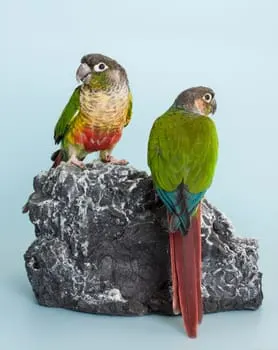 The Maroon Bellied Conure is a popular bird that is bold, bright, and highly colorful.
The Maroon Bellied Conure is a popular bird that is bold, bright, and highly colorful.
The bird is found exclusively in South America and can be spotted in southeastern Brazil, Paraguay, northern Argentina, and Uruguay.
While wild capture of birds still occurs, conures can be successfully bred in captivity.
Where do Green Cheek Conures Live in the Wild?
Comparatively, the Green Cheek Conure is another popular type of conure that is often confused with the Maroon Bellied Conure because of its similar coloration.
Although also found in South America, this bird has a slightly different range in the wild. The Green Cheek Conure is commonly found in Brazil, Argentina, Bolivia, and Paraguay.
Luckily, the vast majority of Green Cheek Conures are available to bird enthusiasts as a pet are bred in captivity.
What Are Cage Requirements Needed For a Maroon Bellied vs. a Green Cheek Conure?
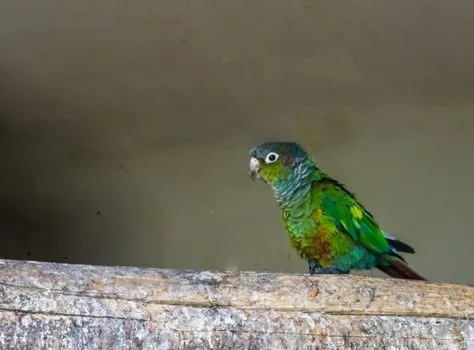 Although both the Maroon Bellied and Green Cheek Conure are similarly sized, these two birds have slightly different energy levels.
Although both the Maroon Bellied and Green Cheek Conure are similarly sized, these two birds have slightly different energy levels.
A Green Cheek Conure is somewhat more active and will need more space in its cage. At a minimum, you’ll want to find an enclosure that measures 24 x 24 inches and at least 30 inches high.
Comparatively, the Maroon Bellied Conure requires slightly less room. For this bird, a 20 x 20-inch cage will be suitable, but the cage must be at least 36 inches tall.
Keep in mind that this is the best cage size for housing a single bird. If you plan to keep a pair of conures, regardless of breed, you’ll want to have a much larger enclosure for your birds to remain healthy and well-exercised.
Cages should always be constructed with durable steel to prevent the conure from biting through the cage and escaping.
Are Maroon Bellied Conures and Green Cheek Conures Social Birds?
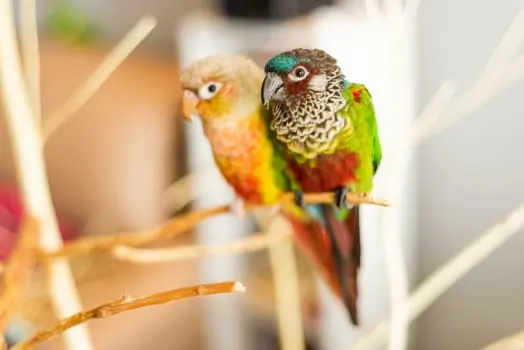 Both the Maroon Bellied and Green Cheek Conure are incredibly social birds that enjoy the attention and affection of their human owner.
Both the Maroon Bellied and Green Cheek Conure are incredibly social birds that enjoy the attention and affection of their human owner.
These two birds benefit largely from having regular and routine playtime and interaction. Both birds will appreciate having a single companion in their cage but probably should not be kept in small groups.
It is alright to house a Maroon Bellied Conure with a Green Cheek Conure, as long as the two birds are about the same size.
Always be sure to keep birds of the same sex living in the same cage to avoid unwanted breeding.
When it comes to their personality, Maroon Bellied Conures can tend to nip their human owners on occasion, especially as the bird reaches sexual maturity.
From this standpoint, the Green Cheek seems to be the friendlier of the two bird species. Both birds can form a close bond with all family members but have also been known to become “one person” birds.
Which Bird Is Easier to Find?
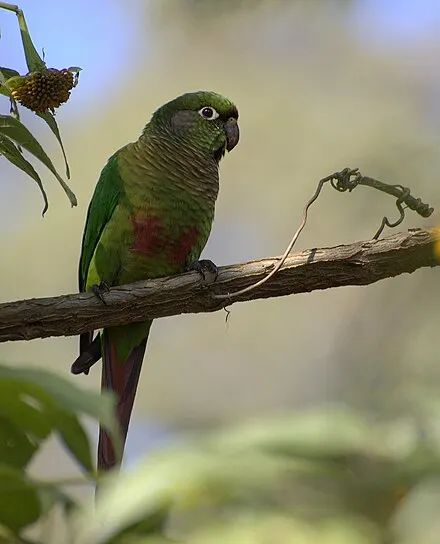 Luckily, both the Maroon Bellied and the Green Cheek Conure are readily available and decently easy to find.
Luckily, both the Maroon Bellied and the Green Cheek Conure are readily available and decently easy to find.
Compared to other available conures housed as pets, both of these species can be found at a local pet store, adoption center, or specific breeders.
If possible, adopting a conure from a shelter or choosing a conure from a breeder is always the preferred option.
Because both the Maroon Bellied and the Green Cheek Conure are readily found in pet stores and look very similar, the two birds are often mislabeled and confused with one another.
While some illegal pet trading still occurs with wild-caught conures, most of these birds are bred in captivity.
What Do Maroon Bellied Conures and Green Cheek Conures Eat?
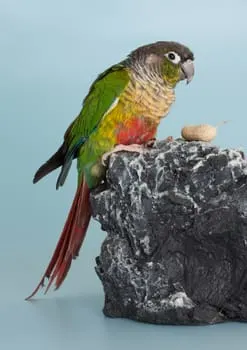 The Maroon Bellied and Green Cheek Conure are close cousins to one another and have very similar diet requirements.
The Maroon Bellied and Green Cheek Conure are close cousins to one another and have very similar diet requirements.
A healthy diet is essential for any conure to keep the bird healthy and happy. You’ll want to give your bird a mix of seeds, fruits, berries, and nuts.
In the wild, some conures will even eat meaty insects and larvae. High-quality birdseed is essential for this species.
Supplement your bird’s diet with plenty of fresh fruits and vegetables, including bananas, melons, apples, and grapes.
Giving your bird vegetables like peas, broccoli, and carrots will also help keep your conure happy.
You’ll want to avoid any food that has dairy or meat. The conure’s digestive tract is not equipped to process and digest these heavy foods properly.
Avoid giving your conure any fruit seeds, and avoid peanuts and avocado.
Although commercially blended seed and pellet mixes are available at the pet store, be sure to supplement this diet with fresh fruits and vegetables.
Avoid purchasing pellets of all standard sizes and shapes and opt for variation, which gives your conure some enrichment and excitement while eating.
How Many Exercises do Maroon Bellied and Green Cheek Conures Require?
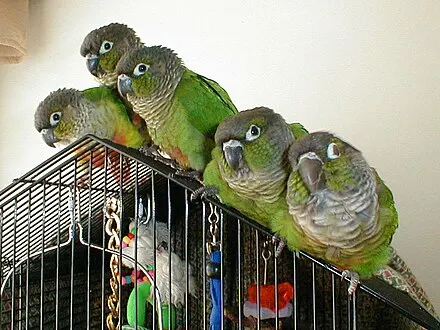 When comparing the two conure species, both birds are extremely active and adventurous. However, the Maroon Bellied Conure tends to be more reserved and shy than the Green Cheek.
When comparing the two conure species, both birds are extremely active and adventurous. However, the Maroon Bellied Conure tends to be more reserved and shy than the Green Cheek.
This bird is alright with a smaller cage and slightly less time spent outside the cage playing and exploring.
Comparatively, the Green Cheek Conure has been described as a clown. This little bird is good-natured and loves to explore.
The bird needs more room to exercise and generally is happier with its human family, especially if it can play together.
A Green Cheek Conure is also a better option if you have small children in the family. The little bird is tolerant of a child’s antics, while a Maroon Bellied Conure is prone to nip.
Which Bird Is Louder?
The conure is a quiet species that doesn’t squawk particularly loudly compared to other birds. However, the Maroon Bellied Conure is a far louder bird than the Green Cheek.
This bird is prone to loud shrieks and squawks, especially when it wakes up first thing in the morning.
However, the Green Cheek is often the preferred bird by pet owners because it is relatively quiet and doesn’t reach the same volume level as the Maroon Bellied Conure.
Both birds are incredibly intelligent but have a limited vocabulary. These birds are not great talkers but can learn a small number of words. It is a reasonable expectation to teach a conure about 15 to 20 words. Generally speaking, the Maroon Bellied Conure is more likely to chat and say human words than a Green Cheek.
Which Bird Has Brighter Coloration?
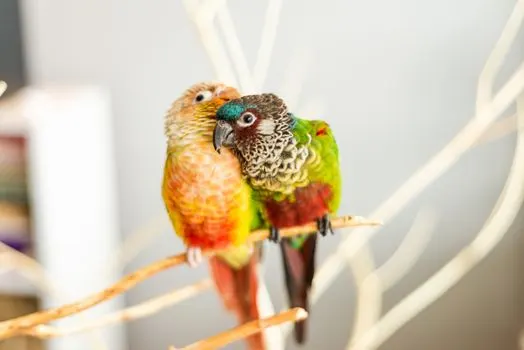 The Maroon Bellied and Green Cheek Conure have brightly colored patterns filled with vibrant red and green colors. These two birds look very similar and are often confused at pet stores.
The Maroon Bellied and Green Cheek Conure have brightly colored patterns filled with vibrant red and green colors. These two birds look very similar and are often confused at pet stores.
However, the Green Cheek Conure tends to have slightly brighter coloration. There are also more color variations available in the Green Cheek species.
While both birds have a reddish stomach, the Maroon Bellied Conure’s colors appear more muted. Seen side by side, the Maroon Bellied Conure will have duller colors than the Green Cheek.
Related Questions
Should I let my pet bird fly out of the cage?
Most pet birds, including conures, are incredibly social, curious, and active birds. Spending time outside the cage every day is a great way to exercise your bird and provide enrichment.
Of course, you’ll always want to supervise your bird outside the cage and provide quality time together playing and interacting.
Never allow your bird to fly outside the cage when other, potentially dangerous, pets are in the same room.
How much does a conure cost?
The price range for a conure varies drastically depending on the specific species of bird you are adopting.
For a Maroon Bellied or a Green Cheek Conure, expect to pay between $250 and $550, with Maroon Bellied Conures being slightly more expensive.
Some extremely rare conure species can cost up to $3,000 for rare coloration or breeding bloodlines.
Related Guides
Our team is composed of pet care professionals, veterinarians, and pet owners. To date, we’ve conducted thousands of hours of research to publish the most accurate pet information.
Most of the writers on our site are vets with 10+ years of clinical experience, ranging from small practice, to equine practice, academia, and surgery. Our goal is to help every pet owner get the information they seek about their dear companions.

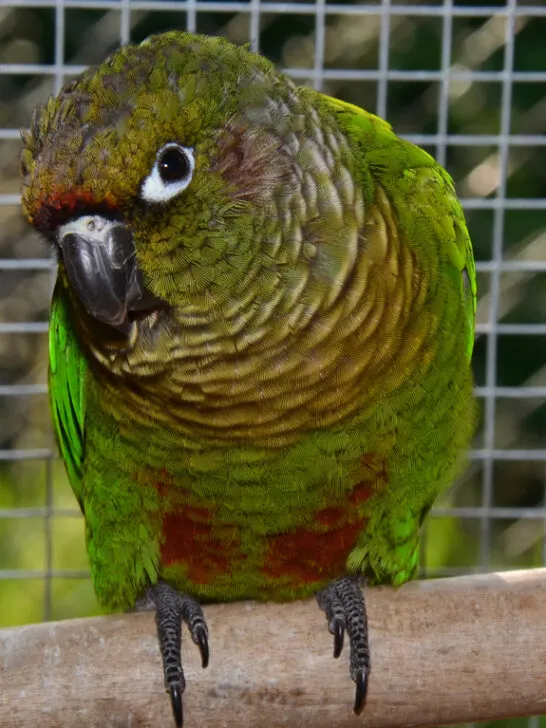

Leave a comment
You must be logged in to post a comment.